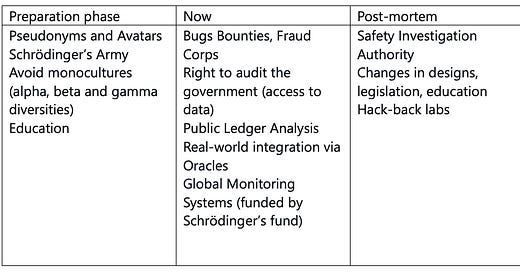Defence: Time Dimension
Next: Infrastructure in a Box (new topic)
Last but not least, lets discuss the time aspect: we can prepare against problems, detect and solve current ones and after recovery, what should we do to prevent them from occurring again. Like in evolution, we should be getting better as time goes by (more adapted and have ability to adapt faster)
Below the concepts we have presented with a few thrown in that we’ll cover in future:
Preparatory phase for spotting weak areas and passive protections:
Schrödinger’s army is a method of lowering risk of external aggressions and responding rapidly in decentralised manner should something happen.
The keystones analysis and calculating alpha, beta and gamma diversities give indication how fragile the system is based on concepts adapted from biology.
Educated population is always better equipped to meet an unpredictable future (assuming the education gives practical and analytical tools)
Online anonymity has both positive and negative sides. It allows people to express their opinion without fear of repression from power holders. At the same time it allows misconduct online go unpunished.
Detecting present weaknesses:
Bugs bounties are a system allocating payments to people who detect weaknesses on any systems used by the society. Fraud Corps are a public side system raising awareness that not everything that glitters is gold.
Citizens’ Right to Audit the government means that automated programs can go though all material the public side has on me to ensure that decisions made follow the law and automatically file for reclamation if this is not so.
If transactions are stored on public ledgers (the web3 model), it becomes easy for anyone to create analytics programs on any area to follow how the society is developing. This will also reveal weaknesses.
Oracles are a concept integrating real-world data into blockchain based solutions (to be discussed later)
Citizens’ automation budgets or Schrödinger’s fund concepts can be used to create global or national monitoring systems for detecting weak spots or ongoing breaches.
Post-mortem:
The idea of Safety Investigation Authority is that whenever a fault or big mistake is detected on any level in society, a team of professionals studies root causes and proposes changes. The idea is copied from airline business.
Safety Investigation Authority reports lead to changes in laws, system designs and education
Hack-back lab is a concept of using honey pots and active measures to gain understanding what adversaries are after and what weaknesses they have found in our deployed infrastructure
Development models
Having good ideas is not enough, they also need to be built. Agile principles such as Kanban and direct customer (citizen) involvement (Citizen’s Automation Budget and Governmental Kanban) can be used. Internally they all are based on a fast-learning loop sometimes called OODA loop.
This is a way of quickly learning and adapting one’s behaviour to reality based on that. OODA comes from Observe (what is happening), Orient (look for solutions, things to do, minuscule technical test), Decide (make up mind what to do), Act. After acting you once again observe that was result.
Agile teams apply OODA principle also on the upper level. Not only do they observe and adapt that they do but also the way they work. That’s why it is impossible to write exact specification how to be agile. A starting point can be defined but from there onwards it is pure Brownian motion, bumping around until better path forward is found and then again continuing experimentation.
Agile methods are used in Internet services where in most services the errors do not have such big effects than many other domains. You wouldn’t want fast experimentation in ship building or medicine development for example. How to adapt agile for complex physical domains is an interesting area for the future. It’s not clear what is the best or even working alternative (or if one even exists). Below some ideas.
In generative design computers generate an endless list of potential designs through iteration. These are tested in simulators to weed out obviously failing ones. This approach produces speed but it is only as good as the simulators. If some essential aspect is missing in the simulator, the results can be misleading
For social systems there are formal methods for solving complex problems. They typically start by modelling all stakeholder, their goal and dilemmas (simultaneous goals that nullify each other), criteria affecting decision making, all factors affecting the criteria, constraints etc. The factors are drawn into a network showing how factors affect each other and how they connect to criteria. Then different actions are considered and the defined models are used to see how the end result is likely to turn out, what their impact to stakeholders is. These frameworks go by names such as “Solving Complex Problems” and you can find online courses and books on the topic.
Token engineering is an approach of simulating social systems incentivised by some token design. In it the model of the system is formally defined by programming its rules into the simulation environment and letting simulators show how the model works. This smokes out designs that obviously fail but cannot prove that the design will always work with real people. An example of such an environment is cadcad.



